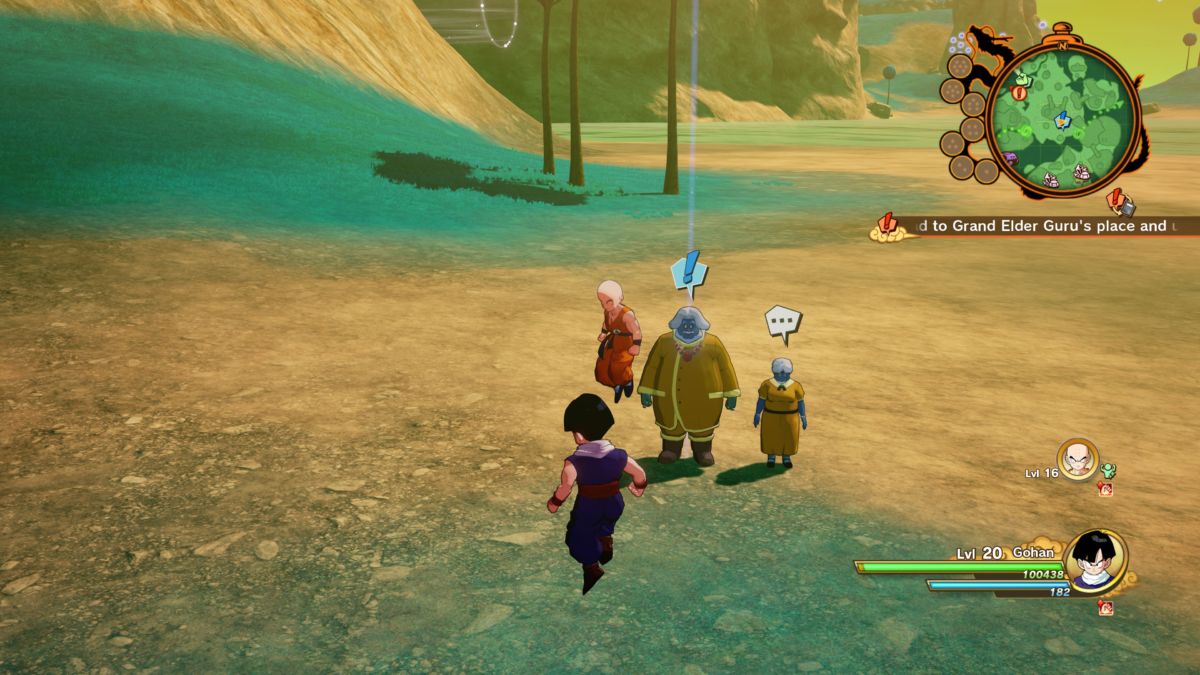Dragon Ball Z: Kakarot has finally launched, meaning it’s time for fans of the franchise to gather round and sing Cha-La Head-Cha-La at the top of their lungs once again while playing the latest game. It’s a whole thing, don’t worry about it. Still, regular Dragon Ball game lovers might be surprised by some of the differences Kakarot offers.
While the gameplay still very much revolves around large scale 3D arena brawling, similar to the Xenoverse series and the games that have come before that, Kakarot has more RPG elements and features, along with some unique ways of levelling up your character. With that in mind, we’ve compiled some beginners tips that should make your time with the game that much easier.
1. Manage Your Ki

As with all Dragon Ball games, your Ki is your most important resource (other than your health, obviously), as it dictates what you can do in a fight. Without Ki, you won’t be able to use super attacks or teleport behind your opponent while they’re attacking. You also won’t be able to super charge, which allows you to close the distance between yourself and your opponent. With that in mind, make sure you charge your Ki when needed.
2. Don’t Just Mash Buttons

Kakarot, like other 3D Dragon Ball games before it, features quite a simplistic combat system with just the one button for melee attacks. While the simplification makes learning the controls for the game much easier, it does also mean you can get into the habit of mashing the button until the enemy falls over.
Don’t.
A large majority of the enemies you’ll face throughout the game utilise moves with super armour, meaning they’ll take damage but carry on charging their move. They’re usually easily telegraphed, but if you’re too busy wailing on your opponent to notice, you’re going to get blown up. Still, it’s worth noting that one particular fight versus Vegeta requires you to knock him out of charging his Galick Gun attack, but this moment is punctuated with a lifebar above Vegeta’s head. Basically, if you see a lifebar, go all in, but if not, retreat and fire from afar.
3. Avoid Villainous Enemies Early On

A couple of chapters into the Saiyan Saga, you’ll encounter what’s known as a Villainous enemy. These are highly powered versions of normal enemies that really cause problems for you. While this encounter is scripted and isn’t too difficult, you’ll see them flying around the different areas of the map from that point on, and you should avoid them at all costs.
The scripted encounter pits you against enemies that are matched to your level, so it’s an even fight, yet the enemies you encounter while flying around in the Saiyan Saga are about 20 levels higher than you are. I tried these fights, out of curiosity, and got smashed out of the sky like I was suddenly playing One Punch Man against Saitama. Basically, avoid those fights for a while, you’ll be strong enough later.
4. Always Do Sub-Quests

It wouldn’t be an RPG without side quests of some kind, and Kakarot has more than enough to distract you from the main quest. It’s a bit of an obvious point, but it’s one that bears repeating: make sure you do complete those Sub-Quests, as they often grant a generous amount of EXP and, in some case, add Soul Emblems to your Community boards. We’ll get to those in a second.
Anyway, back to the sub-quests. While Kakarot might seem like an open-world RPG, it’s not. Depending on the context of the story, you’ll often be locked as a specific character, or can only explore one area. Because of this, the game employs lots of “points of no return”, where you’ll be asked if you would like to keep exploring or continue the story, so it’s worth completing sub-quests as soon as they become available. Once you see a blue exclamation mark on your map, head that way.
5. The Community Boards

One of the most unique ways of improving your character comes in the form of Community Boards. As you progress through the game and encounter new characters, you unlock Soul Emblems that can be placed on a community board which can improve all of your base stats. Each character is proficient in a certain type, so you need to work out where the character is best placed as spaces on each board are limited.
On top of that, depending on how you choose to arrange your characters, you can achieve boosts to the community board’s rank. Certain characters can receive extra power if they’re placed next to each other, so you need to work out how to optimise your board. In some situations, it’s worth using a soul emblem on a board they’re not the best at just to trigger a potential link bonus. The game will tell you about these bonuses, it’s just up to you to figure out how to implement them.
6. Giving Gifts

You can improve the power of Soul Emblems by giving gifts, which can be used to improve the Emblem’s proficiency on a community board. These gifts can be earned as a reward for quests or as loot, and they’re worth using as soon as you get them. Gifts will also increase your friendship rating, which offers its own rewards depending on the character, so make sure you’re always feeling generous.
7. Kiss The Cook

Another way you can improve your stats is by eating a good meal. There are various ways to cook food in Kakarot, and depending on the quality of the ingredients used or whether it was a cooked at a campfire, a small dish or a full course, the benefits will change drastically. Whichever way it was prepared, there are two clear benefits to eating food, as you’ll see increased stats in both the short and long term.
In the short term, you’ll receive a percentage buff to certain stats that lasts for a couple of minutes, which can be helpful before big fights. As for the long term, you’ll also receive small but permanent upgrades to stats like attack power or overall HP. Full course meals will offer huge upgrades, but they’re harder to create and can only be made by Chi-Chi. You’ll only have your first one after you finish the Saiyan Saga, and you’ll need to learn the recipes for it, but the upgrade is worth the effort.
8. Super Attacks Need Upgrading

Oh look, another way of upgrading yourself. Kakarot really leans into the RPG mechanics, as there’s a skill tree for each character in the game that focuses on improving your super attacks. In order to improve your super moves, you need to collect coloured Z Orbs that can be earned from wandering around in the environment or by winning fights. The colour of the Orb is related to where you’d find it, so you’d find blue orbs near water, green in forests, and red in deserts.
Upgrading your moves improves the amount of damage they do, so it’s worth keeping tabs on what needs upgrading. You do switch characters often, but you also earn orbs like they’re going out of fashion, so the upgrades should keep rolling in. You also unlock new Super Attacks, and can progress further down the skill tree as you make your way through the story, but you need to make sure you equip the moves you unlock in the first place.
9. Getting More From The Skill Tree

For some super attacks, you need to complete Training exercises in order to unlock them. Training missions will require D Medals, which can be found in the environment, earned as a reward for quests or through other means. Unlocking these moves will give you more ways to customise your character loadout while granting more upgrades to unlock.
On top of that, the Super Attack Skill Tree features an entirely separate tree that focuses on levelling up “Know-how” skills. These skills are equippable buffs that can improve how much damage you deal to stunned enemies and so on. They’re worth looking into if you have the spare Z Orbs.
10. Something For Nothing

Everyone likes to receive something for doing practically nothing, and Kakarot offers a system that allows for just that. Throughout the game, you’ll unlock new Encyclopedia entries that give you more of an insight into the wider Dragon Ball universe. As you hit certain milestones, you’ll unlock new rewards, including gifts that can be used for Soul Emblems on the Community boards.
There’s also the Turtle School Training Manual, a series of objectives you’ll complete throughout the course of the game that offer in-game rewards. You’ll meet these requirements naturally, but you need to turn these quests in with Master Roshi at Kame House once completed. Unfortunately, you can only start turning them in after the Saiyan Saga, and even then you have to complete a couple of quests before you’ll be allowed to.
Some of the coverage you find on Cultured Vultures contains affiliate links, which provide us with small commissions based on purchases made from visiting our site.

